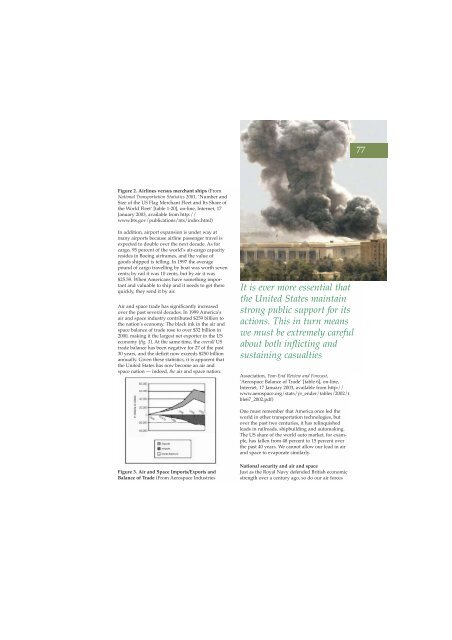Volume 6 No 4 - Royal Air Force Centre for Air Power Studies
Volume 6 No 4 - Royal Air Force Centre for Air Power Studies
Volume 6 No 4 - Royal Air Force Centre for Air Power Studies
You also want an ePaper? Increase the reach of your titles
YUMPU automatically turns print PDFs into web optimized ePapers that Google loves.
77<br />
Figure 2. <strong>Air</strong>lines versus merchant ships (From<br />
National Transportation Statistics 2001, ‘Number and<br />
Size of the US Flag Merchant Fleet and Its Share of<br />
the World Fleet’ [table 1-20], on-line, Internet, 17<br />
January 2003, available from http://<br />
www.bts.gov/publications/nts/index.html)<br />
In addition, airport expansion is under way at<br />
many airports because airline passenger travel is<br />
expected to double over the next decade. As <strong>for</strong><br />
cargo, 95 percent of the world’s air-cargo capacity<br />
resides in Boeing airframes, and the value of<br />
goods shipped is telling. In 1997 the average<br />
pound of cargo travelling by boat was worth seven<br />
cents; by rail it was 10 cents, but by air it was<br />
$25.59. When Americans have something important<br />
and valuable to ship and it needs to get there<br />
quickly, they send it by air.<br />
<strong>Air</strong> and space trade has significantly increased<br />
over the past several decades. In 1999 America’s<br />
air and space industry contributed $259 billion to<br />
the nation’s economy. The black ink in the air and<br />
space balance of trade rose to over $32 billion in<br />
2000, making it the largest net exporter in the US<br />
economy (fig. 3). At the same time, the overall US<br />
trade balance has been negative <strong>for</strong> 27 of the past<br />
30 years, and the deficit now exceeds $250 billion<br />
annually. Given these statistics, it is apparent that<br />
the United States has now become an air and<br />
space nation — indeed, the air and space nation.<br />
It is ever more essential that<br />
the United States maintain<br />
strong public support <strong>for</strong> its<br />
actions. This in turn means<br />
we must be extremely careful<br />
about both inflicting and<br />
sustaining casualties<br />
Association, Year-End Review and Forecast,<br />
‘Aerospace Balance of Trade’ [table 6], on-line,<br />
Internet, 17 January 2003, available from http://<br />
www.aerospace.org/stats/yr_ender/tables/2002/t<br />
ble67_2002.pdf)<br />
One must remember that America once led the<br />
world in other transportation technologies, but<br />
over the past two centuries, it has relinquished<br />
leads in railroads, shipbuilding and automaking.<br />
The US share of the world auto market, <strong>for</strong> example,<br />
has fallen from 48 percent to 15 percent over<br />
the past 40 years. We cannot allow our lead in air<br />
and space to evaporate similarly.<br />
Figure 3. <strong>Air</strong> and Space Imports/Exports and<br />
Balance of Trade (From Aerospace Industries<br />
National security and air and space<br />
Just as the <strong>Royal</strong> Navy defended British economic<br />
strength over a century ago, so do our air <strong>for</strong>ces
















